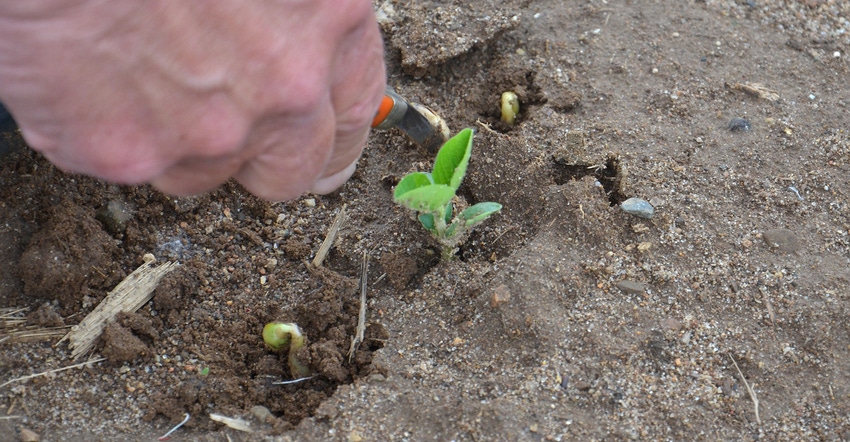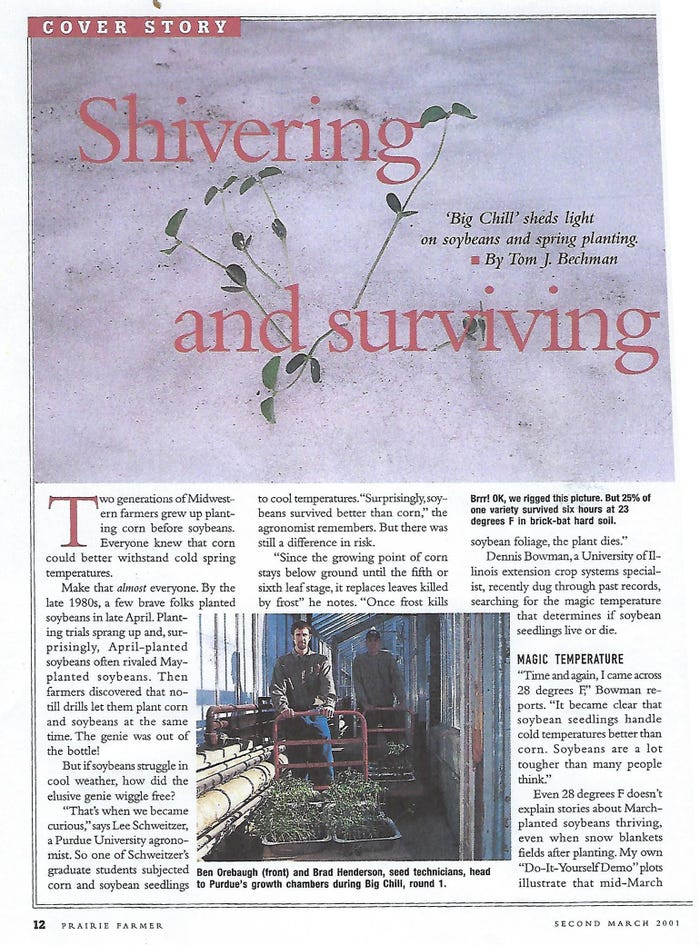
While most people who have crops planted are more worried about how well just-emerged soybeans will withstand freezing temperatures than corn, some evidence indicates that soybeans can withstand colder temperatures than most people think. And while most think corn is safe if the growing point is under the ground, that may depend on just how cold it gets.
First, here’s the scoop on soybeans. In the Second March 2001 editions of Indiana Prairie Farmer, the cover story was “Shivering and surviving,” featuring an exclusive report on what was called the Big Chill project. The goal was to determine how well young soybeans survived cold temperatures. The study evolved because more people were planting soybeans earlier.
Kevin Cavanaugh, director of research for Beck’s, agreed to help Indiana Prairie Farmer with the project. Herb Ohm, then a wheat breeder at Purdue University, provided cooling chambers designed for plant research.
Three stages of growth, from just emerged to first trifoliate, were exposed to 30 minutes, two hours and four hours at 32, 29 and 26 degrees F. Three varieties were tested. What Cavanaugh reported in the article was that only the biggest plants exposed for the longest times and coolest temperatures showed damage.
“We didn’t go cold enough!” he said, since the goal was to find what temperature it took to kill emerged soybeans. Even at 26 degrees for four hours in the hypocotyl, or just-emerged, stage, there was virtually no damage to any of the seedlings. At 26 degrees at four hours in the unifoliate stage, 80% to 90% of plants survived. Losses were minimal at 26 degrees and two hours for two of the three varieties. It took four hours at 26 degrees to get losses of 50% or greater at the trifoliate stage.
Beck’s conducted a second test with soybeans at the unifoliate stage, going even colder. Cavanaugh observed that 28 degrees, even for six hours, didn’t touch them. It took four to six hours at 25 degrees to reduce stands by half, he noted. Some plants survived even at 23 degrees.

FROM THE ARCHIVES: This story from 2001 (above and below) reported on a special study carried out by Beck’s in cooperation with Purdue University. It demonstrated that young soybeans can survive subfreezing temperatures, depending on size of the plant and hours of chilling.


Real world
Beck’s findings in these experiments agreed with work Purdue agronomist Lee Schweitzer did earlier. He and his graduate student determined that soybeans withstand colder temperatures better than corn.
Note that temperatures can vary within microclimates. And it could be cooler at ground level than at reported air temperatures, normally measured at about 5 feet above the surface.
Here’s the biggest rub, however. If it does get cold enough to kill soybeans, they’re done — the growing point is above ground level. Corn leaves may be damaged by frost or freeze, but if the growing point is below ground and not damaged, plants will regrow with little or no permanent damage.
However, Bob Nielsen, Purdue Extension corn specialist, says there is a big difference between 32-degree frost damage on corn and a 28-degree freeze. He notes that if it actually stays at 28 degrees or lower for one to two hours, especially if soil is dry, it could kill the growing point, even if it is below ground.
The best advice for soybeans or corn is to give damaged fields three to five days to recover before making decisions. Nielsen says that after three to five days, you will know whether corn plants are showing signs of regrowth or not.
About the Author(s)
You May Also Like




